
Birmingham's old children's library: The Centre for the Child
Here's what Neil Gaiman says about his childhood library:
I was lucky. I had an excellent local library growing up. I had the kind of parents who could be persuaded to drop me off in the library on their way to work in summer holidays, and the kind of librarians who did not mind a small, unaccompanied boy heading back into the children’s library every morning and working his way through the card catalogue, looking for books with ghosts or magic or rockets in them, looking for vampires or detectives or witches or wonders. And when I had finished reading the children’s’ library I began on the adult books.
They were good librarians. They liked books and they liked the books being read. They taught me how to order books from other libraries on inter-library loans. They had no snobbery about anything I read. They just seemed to like that there was this wide-eyed little boy who loved to read, and would talk to me about the books I was reading, they would find me other books in a series, they would help. They treated me as another reader – nothing less or more – which meant they treated me with respect. I was not used to being treated with respect as an eight-year-old.
Neil Gaiman could have been talking about my childhood library, the Centre for the Child in Birmingham city centre. I don't think he was though because he grew up in Sussex. Still though, he might have been.
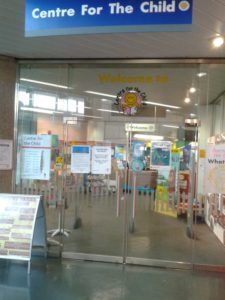
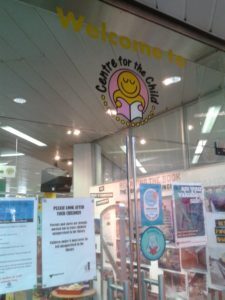
Centre for the Child was housed in a bigger library, Birmingham's main library, officially called Birmingham Central Library but which my family and I called "town library".
My family and I went to Centre for the Child quite often. Every week, in fact. Now that I think about it, the reason we went so often was that we were poor, and the library was one of the things in Birmingham that was free, along with looking in shops without actually buying anything
Every Tuesday evening - always Tuesdays because the library opened late, until 8 pm, on Tuesdays - my dad would drive us all to the centre of Birmingham. We'd park one of the side streets, a street that has parking meters nowadays. We'd walk to the Centre for the Child. My brother, sister and I would spend almost the entire time not looking for books but playing games on the computers. The games came on CD-ROMs which the librarians kept in a big box. We had to ask for the games, and the librarians would bring the box out from under the counter, like a porn shop owner bringing out their most perverted porn videos. Once I wanted to play How Many Bugs in a Box? because I liked the graphics but my mom told me I was too old for it and suggested I play something else.
Games I remember were Arthur's Computer Adventure and Mixed-Up Mother Goose. I finished Mixed-Up Mother Goose in one sitting. You had to finish it in one sitting beceause at 8 pm the librarians would turn the computers off. Week after week I played that game until I knew exactly where each of items and characters were and I could finish sorting everyone out in Nursery Rhyme Land in just under an hour. All the librarians were impressed as they had never seen the ending of the game before.
When we were done playing computer games, my brother, sister and I would run around finding books to borrow, like Goosebumps, Spooksville and Animorphs. The library allowed us to take out eight books each, which meant we would take home 24 books between us each week. Somehow we'd read them all within a week, ready to return them to the library the next Tuesday.
There was also a non-fiction section that I didn't spend much time in. Then there was a section with "big books" - books that were fiction but too big to fit on the ordinary shelves. It was here that I could sometimes find the best books of all: puzzle books.
The library also had a baby area, a homework area, a teenage area (where teenagers could get high on knowledge instead of heroin), computers and even meeting rooms, which I don't remember ever seeing.
There was also a separate room containing childcare books. Sometimes my parents would go in there and read books about how to be better parents, god bless them.
The library also had its own staff and manager, as well as its own desk for checking out books.
Then there was a homework club (I'm not sure what the appeal of this club was supposed to be) on Monday and Thursday afternoons. There was also something called "Stories from the Web" club, which is where children worked with library staff to update a website about stories and poems. Sounds like something I would have enjoyed.
Photos of the library
The display area and reception:

The computers, mainly used to play CD-ROM games:
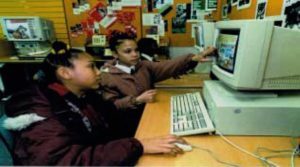
The teenage area:

The baby/toddler play area:
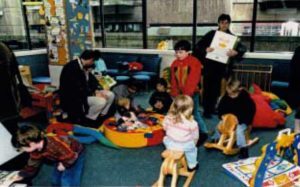
Here's a photo of me after completing the 'Reading trail'.
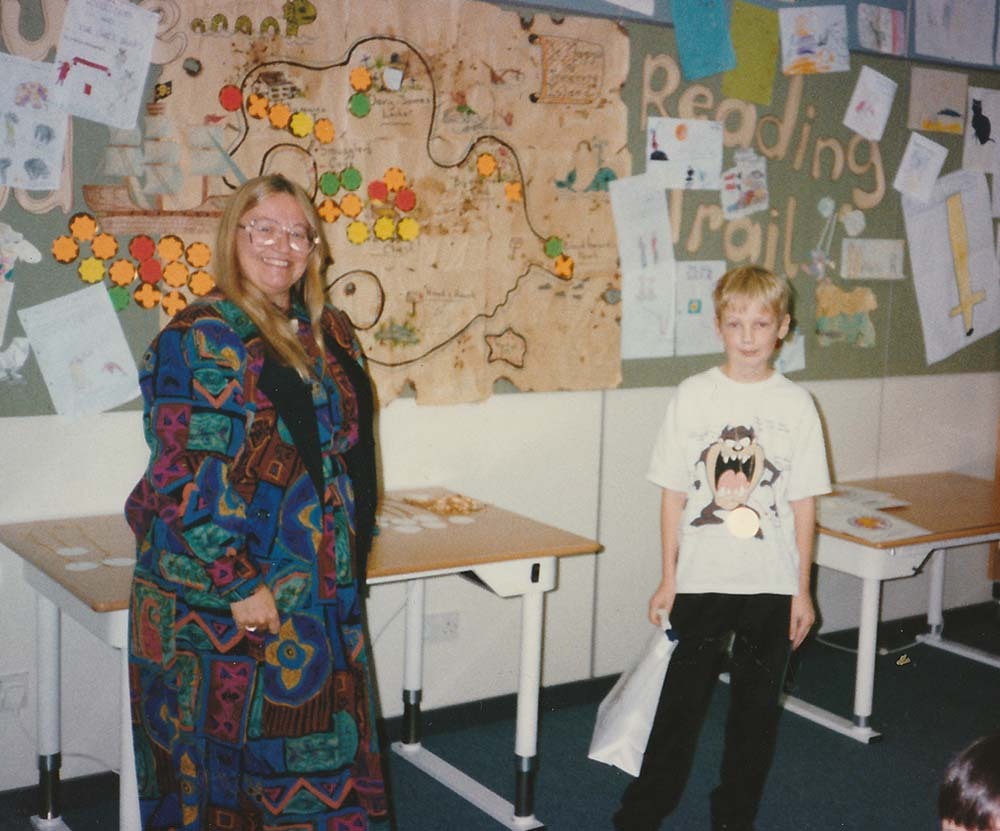
Just look at that librarian. That's the kind of person you want as a children's librarian. She looks like a kind grandmother/hippie dressed in a 1990s carpet. In fact, that woman is Annie Everall, a librarian who received an OBE in 2001 for her services to children’s books and libraries. And it's not just the Queen who has praised Everall's work; writer Jacqueline Wilson had this to say:
Annie Everall has been my professional colleague and dear friend for many years. She is informed, efficient and ultra-reliable and I couldn’t recommend her more highly.
The previous library
Centre for the Child was a phoenix from the flames. Its predecessor, the previous children's library, was the victim of an arson attack. In an article from 1994 called "Library Security in the UK: Are Our Libraries of Today Used or Abused?", Davin Ewing writes:
In April 1991, Birmingham Central Library was attacked by arsonists. Approximately £1 million of damage was caused. Twenty-thousand books in the children’s library were destroyed by the blaze caused by dousing that part of the building with petrol poured through a broken window. Besides the books, computer equipment, toys and other materials were burnt. The main library was opened the next day, although the whole building was affected by the smoke. However, the children’s library was closed for months.

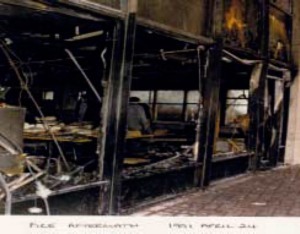
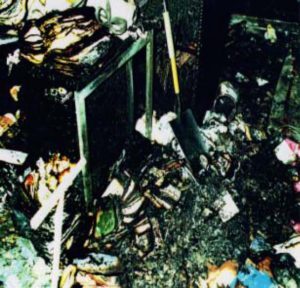
The children's library was completely and thoroughly destroyed according to a pamphlet from 1995. The pamphlet goes on to say that the fire:
resulted in the total loss of its books, equipment and resources and dealt a devastating blow to the quarter of a million children and young people in the City.
Phoenix from the flames
The city council saw the library fire as an opportunity to build a better children's library than the last one – and perhaps more fire-resistant too. A pamphlet from around that time says:
Out of the ashes has come a unique opportunity to plan and develop a Centre for the Child in the City. The Centre for the Child in the City will be the state of the art library and resource centre for children and young people in the 21st century. [...] A place in the heart of the city centre which highlights the importance of the child, welcomes the child and is for the child.
It was this library that would become my childhood library.
Demolition
In 2013, Birmingham City Council demolished Birmingham Central Library and built a new library in its place. I've been to the new library, including the children's section, and I have to admit that's it's actually quite good. But while it's certainly well-stocked, bright, and airy - all the things a children's library should be, I suppose - it's not my library, the one from my childhood. All I have from that library are a handful of photos and a few scattered memories. But perhaps that, dear reader, is how it should be.
Further reading
- Birmingham City Council's Centre for the Child website as it was in 2000, thanks to the Wayback Machine
- The child in the electronic age: New developments in resources and services provided to children by public libraries
- Annie Everall's Planning and Designing Libraries for Children and Young People -the UK Experience
- Stories from the Web by Lydia Matheson and Annie Everall (1999)


Leave a comment